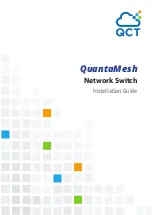
Page 4 of 7 SLX Series
CONTROL PANELS:
Standard control panels are an integral component of the master frame in most SLX Series switchers. The control
panel is located on the front of the master frame. The number of control buttons is dependent upon the switcher matrix
size. All panels provide the same basic switching control functions. These functions include Level control, Follow
mode, Video or Audio only, and Split mode.
Level control allows video and audio inputs to be separated for switching to different outputs or sourced from
different inputs. To understand this function one must know that the video is assigned to Level 1 and audio to Level 2
by default at the factory. There are two LEDs located at the top of each input button. When both LEDs are illuminated
at the top of the input button, it is indicating the Follow mode. Similarly the Level button on the left side of the control
panel has two LEDs. When no LEDs are illuminated at the top of the Level button the indication is that the switching is
performed in the Follow mode. When the Level button is pressed once the red LED will light indicating only Level 1
(video) will switch. A second press of the Level button causes the green LED to light indicating that only Level 2 (audio)
will switch. A third press restores the Follow mode.
Selecting the desired Input button will cause the LEDs on that button to flash. This indicates a preset condition.
When the Take button is pressed the preset input is switched to the assigned output. Single output configurations have
only one Take button. However, dual output configurations may have two Take buttons. The top Take button is for
output 1 and the lower Take button, if provided, is for output 2.
To breakaway the video, the Level button must indicate a Level 1 (red only LED) mode. Press the desired Input
button causing the red LED to flash on that input. When the Take button is pressed, the output will switch to the
selected video input. Note that the previously selected audio source will remain unchanged.
To breakaway the audio on the output, the Level button must indicate a Level 2 (green only LED) mode. Select the
desired input button causing the green LED to flash on the input. Press the Take button to switch the audio channel to
the output. Note that the previously selected video signal will remain connected to the output throughout this process.
A split switch of the video and audio signals can be performed as follows. First, select the Level 1 mode and press
the desired video input button. This causes that input’s red LED to flash. Then, select the Level 2 mode and press the
desired audio input button. This causes the green LED to flash for that input. A split switch is performed when the
Take button is pressed. The input buttons show the status of the split via the red and green LEDs in two different
buttons.
This same control scheme is applicable to the remote control panels available for the SLX Series. The serial port
is the interface for the Remote Control Panel. Therefore, a choice must be made between which device is
implemented for remote control, either a Sigma control panel or another device. Both the integral and remote panels
are active simultaneously. Via the SLX Series protocol, control of the system is functionally the same as the control
panels.
MULTI-CHANNEL VIDEO CONTROL:
Video configurations may include 2C (SVHS) or 3C (RGB, CAV) applications. This is accomplished with multiple
video boards all set to the same level. They are controlled in parallel due to the level control being the same. When a
switch is made from the control device, all output 1 or output 2 boards switch together. If the output boards reside in
different frames they are interconnected for control with the provided ribbon cable.
NOTE: It is necessary to connect the video channel, which contains the sync signal to the master video board in a
multi-channel video application. This is required for detection of vertical interval. If the video channel with sync
information is not connected to the master video switch module the video will switch non-synchronously. This will
cause tearing or vertical roll at the time of the switch. A sticker on the rear of the unit marked “SYNC REF. CHANNEL”
designates the master video switch module. The master video switch module would typically be the top module in the
master frame, which contains the SCI.
In the 2C and 3C systems the video modules are AC coupled to handle signals with or without sync information.
This is required in applications of “sync-on-green” and “Y” signal channels mixed with video or chroma only signals.
Mono or Stereo audio can be present with a 2C or 3C system. Control of the audio modules is set to Level 2.































